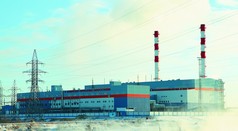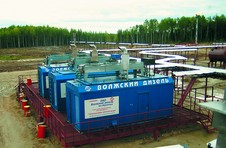 GGS 420 power plant manufactured by Lindenberg-Anlagen GmbH is designed on the base of MAN E2848 LE322 gas engine and Leroy Somer LSA 47.2 Ì8 electric generator. Electric output of the plant is 386 kW. The plant is equipped with Motortech AIO control system.
GGS 420 power plant manufactured by Lindenberg-Anlagen GmbH is designed on the base of MAN E2848 LE322 gas engine and Leroy Somer LSA 47.2 Ì8 electric generator. Electric output of the plant is 386 kW. The plant is equipped with Motortech AIO control system.

Новости
Lonas Technology JSC was awarded the contract by Karaganda Energocanter Ltd. for the development of the project of Karagandinskaya TETs-3 output increasing. Under the project Ò-120/140-12.8 steam turbine will be supplied to the site. It will be equipped by Ò3FP-160-2U3 electric generator. All power equipment will be delivered by Power Machines JSC. The commissioning of new steam turbine power plant is planned at the end of 2011.
The project is realized by the initiative of Krasnodar Area Governor. The station consists of two GE Energy Jenbacher gas engines JMS 620 GS-N.LC power plants. The equipment was supplied by Max Motors JSC. The main fuel for the
station is natural gas. Total electric output of the station is 6 MW. Generated thermal power of 6 MW is used for greenhouses heating. The main production of the farm is fresh roses. The customer of the project is Yug-Agro Ltd. Commissioned power equipment is sinchronized with power plants of the first stage of the projec. Their total output is 5.9 MW.

Total electric output of the station is 122.6 MW, thermal output is 110 MW. The main fuel for the station is cross-country pipeline natural gas. The station consists of two combined cycle power units on the base of GE Energy MS6001B gas tubines each rated at 42 MW. P-131 heat recovery steam generators were supplied ZIOMAR engineering company. Two Ò-15.5/20.3-5.4/0.2 steam turbines were manufactured and delivered by Kaluga Turbine Plant, electric generators for steam turbines were supplied by Electrotyazhmash-Privod.
Construction was performed by the Intertechelectro-New Generation group of companies. The Noyabrsk CCGT power plant is the first large centralized power source and the only generation facility in the Yamal-Nenets autonomous district having such performance. It was fully constructed on the basis of private investments and this is the first medium-power facility built by an independent investor after the Russian Federation power industry reform.
The power plant constitutes the first stage of implementation of the «Industrial Urals-Polar Urals» Project power unit. This power plant is an entity of wholesale electricity market and is included into the summary forecasted balance of electric power generation and supply within the framework of UES of Russia.
The total output of the station will be 50 MW. It will consist of four GTA-8RM gas turbine plants each rated at 8 MW, four KTZ steam turbines and four heat recovery steam generators of Energomash BZEM JSC. The project is realized under regional program for increasing of power sources effectiveness. Additionally under the program some power stations will be built in the Region.
During the presentation of international program of Solar Turbines Inc. and Mr. Yudin, general director of Saturn-Gas Turbines JSC and Mr. Amplby, the president of Solar Turbines Inc. present their joint project of gas turbine plants manufacture organization on the base of production facilities of Rybinsk enterprise. The program stipulates for the staged localization of some Solar plants with key technologies passing to Russian company.
 The station consists of three DE80 gas engine power plants manufactured and delivered by Mamins Volga Diesel Plant JSC. Nominal output of each power plant is 450 kW. They are developed on the base of 280D gas engines. The main fuel for the station is casing-head gas. The station operates on base mode.
The station consists of three DE80 gas engine power plants manufactured and delivered by Mamins Volga Diesel Plant JSC. Nominal output of each power plant is 450 kW. They are developed on the base of 280D gas engines. The main fuel for the station is casing-head gas. The station operates on base mode.
